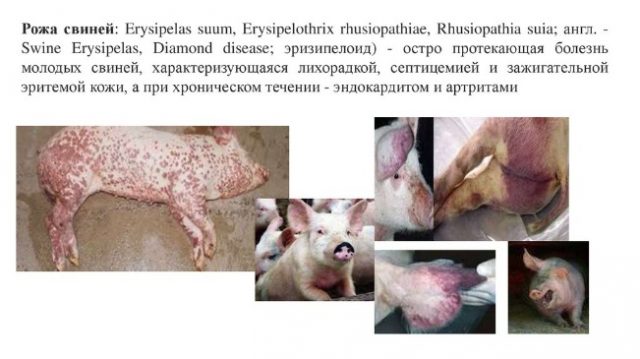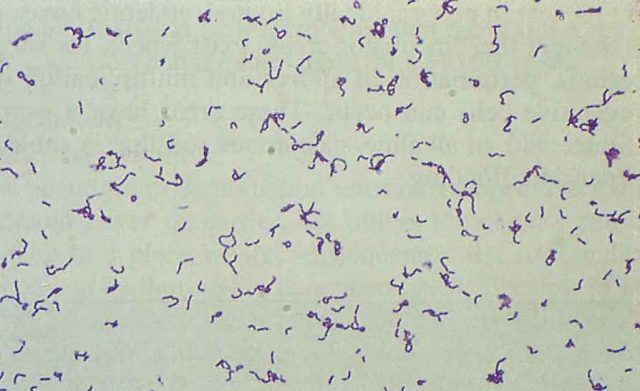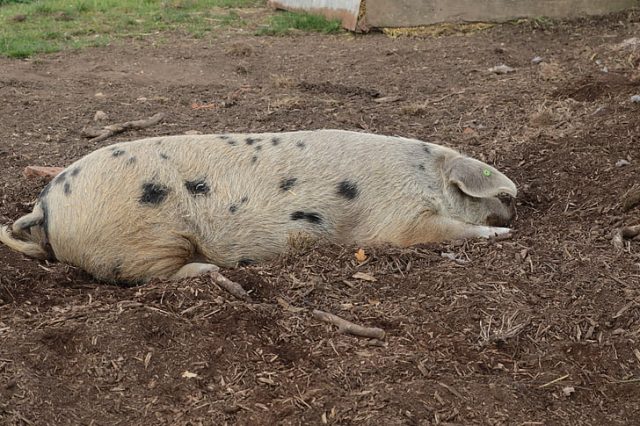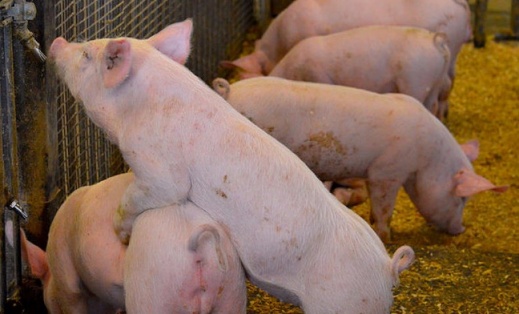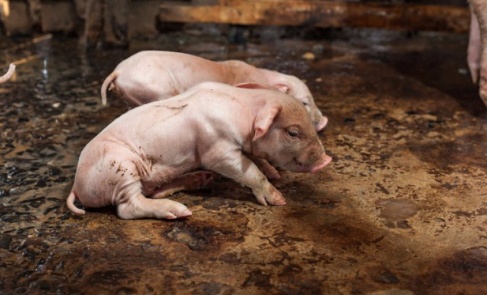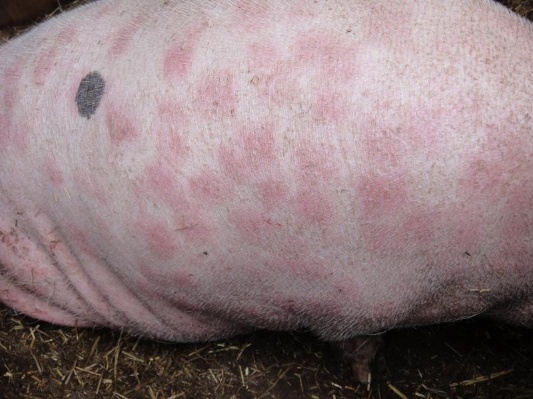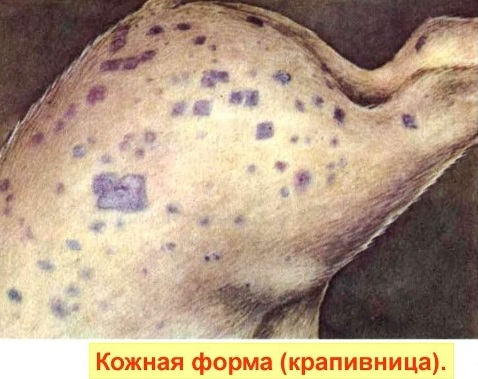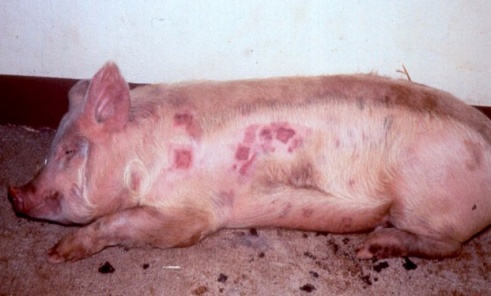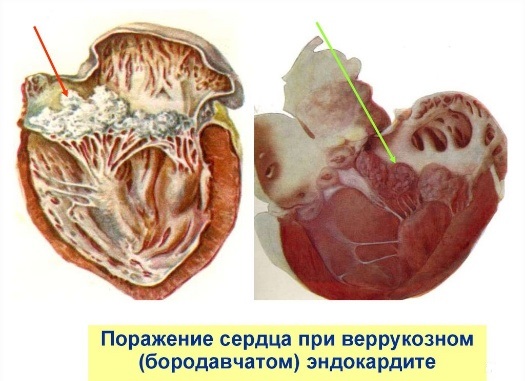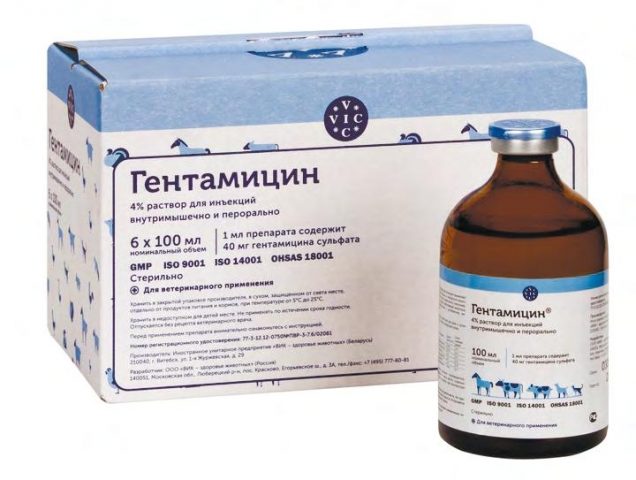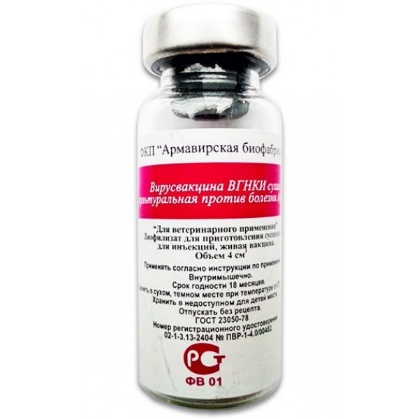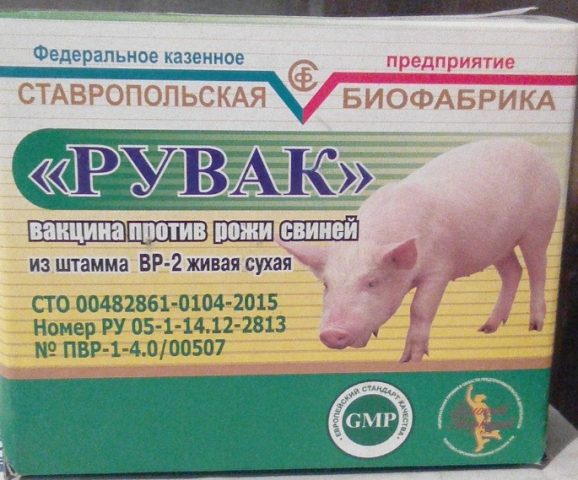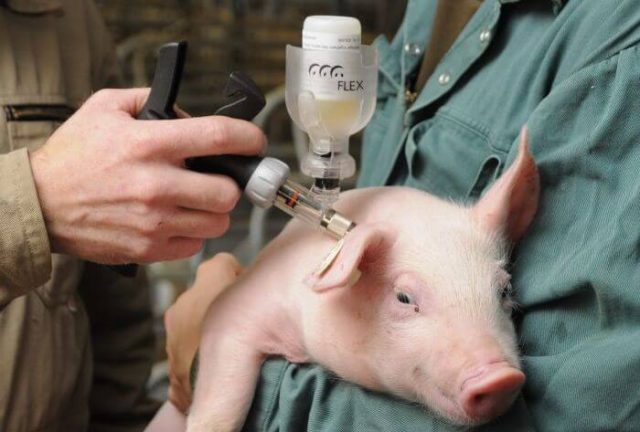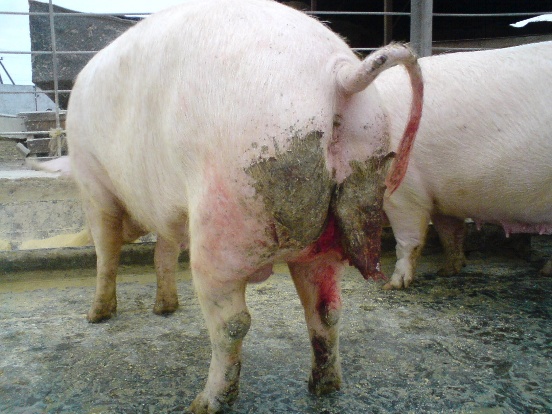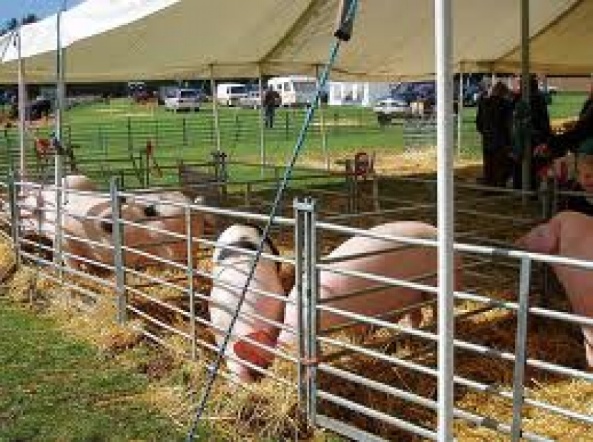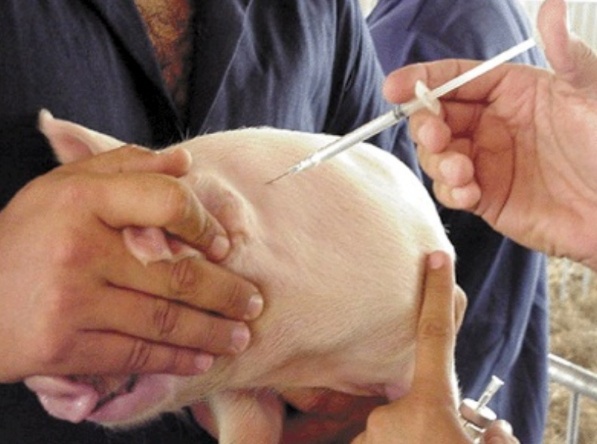Content
Pig farming is the most profitable livestock business. Including breeding pigs in a private backyard. If the local veterinary station has nothing against it. Pigs have rapid puberty. Sows give birth to numerous offspring. Piglets grow rapidly and reach marketable weight already at 6 months. Everything would be fine if infectious diseases did not interfere with a successful and profitable business. swine diseases, often leading to a massive loss of livestock.
One of these diseases is erysipelas in pigs. An infectious disease that can only be treated with antibiotics and is 100% fatal within 3-5 days if treatment is neglected.
Causative agent of the disease
The cause of erysipelas is the bacterium Erysipelothrix insidiosa, which is a ubiquitous microorganism. The bacterium has 3 types: A, B and N. The first two cause the disease. Moreover, type B has high immunogenic properties and is used for the production of vaccines.
The bacterium is highly resistant to the external environment. The causative agent of swine erysipelas remains in corpses for several months. Withstands 1 month when out of direct sunlight. It dies in direct sunlight within a few hours. Sensitive to heat treatment: at + 70 ° C it dies in 2-5 minutes, at + 100 ° C - in a few seconds.
The bacterium is sensitive to broad-spectrum antibiotics and disinfectants. When pork products are smoked and salted, the erysipelas pathogen in pigs fully retains its viability.
Sources of the disease
The disease belongs to natural focal. Bacteria are widespread in both soil and water, so they cannot be completely eliminated. Piglets are most susceptible to the disease at the age of 3-12 months. Like many diseases, erysipelas in pigs is transmitted through carriers of the disease:
- rats and mice;
- birds;
- livestock;
- blood-sucking insects.
The carriers themselves may not get sick, since for them the bacterium is not the causative agent of the disease, but they transfer the infection from sick pigs to healthy ones. Bacteria carriers are also carriers of the disease: clinically healthy animals that excrete infection into the external environment with urine and droppings.
Since pigs are omnivores, they are often fed with sausage waste. Poorly treated waste from a sick pig can be a source of contamination for a healthy herd.
Pigs can only get sick directly from other carriers if the carrier is eaten. But this rarely happens. Basically, the mechanism of infection with erysipelas is different. It can be transmitted through bacteria-contaminated care items and the environment:
- food and water in contact with the carrier of the infection (mice, pigeons, rats);
- inventory;
- litter;
- the floor and walls of the pigsty;
- the soil in which the corpses of dead animals are buried (up to 1 year);
- slurry (several months);
- blood-sucking parasites (if before that the insect drank the blood of a sick animal).
The main route, after all, is the soil, and erysipelas is seasonally susceptible. The peak of the disease occurs in autumn and spring. It is too cold for bacteria in winter, too hot in summer. But if the summer is cold, the pigs can get sick during the summer.
Forms of the disease and their symptoms
Of the 3 antigenic types A, B and N, most cases of infection are in type A. There are much fewer cases of infection with type B, and N very rarely provokes the development of the disease. It is usually isolated from clinically healthy animals.
The causative agent of erysipelas can be present in a clinically healthy animal in a latent form, nesting in the intestinal follicles and tonsils. Under stress, with a drop in immunity, the pathogen can enter the active phase. Therefore, the disease often occurs on farms without a drift from the outside.
The exact picture of how the erysipelas looks in pigs does not exist, since it all depends on the form in which the disease proceeds. The only common feature is the incubation period, which lasts 2-8 days.
The course of erysipelas can be:
- lightning fast;
- sharp;
- subacute;
- chronic.
There can also be 3 forms: septic, cutaneous and latent. With a latent, that is, latent, course, the animal looks healthy, but infects the livestock.
Lightning fast
This type of flow is rarely recorded in pigs aged 7-10 months. Death occurs within a few hours, so the owners do not always have time to notice the symptoms of lightning type erysipelas in pigs:
- an increase in body temperature up to 41-42 ° С;
- refusal of feed;
- oppression;
- sometimes there are signs of damage to the nervous system.
In some cases, red-violet spots characteristic of erysipelas may appear on the neck, in the intermaxillary space or on the inner side of the thighs. But usually these signs do not have time to develop.
Externally, pigs show no signs of disease. It looks like the animal died for no reason, no reason. Without autopsy and tissue examination, neighbors can be blamed for maliciously poisoning the piglets.
In the photo, a pig's erysipelas in a lightning form.
Acute or septic form
The first signs of a septic form of erysipelas in pigs:
- an increase in body temperature up to 42 ° C;
- fever;
- chills;
- weakness;
- refusal of feed.
With the further development of the disease, all these signs persist. A few days later, they are added to:
- unwillingness to get up;
- weakness in the hind legs;
- unsteadiness of gait;
- development of conjunctivitis is possible;
- sometimes there is an urge to vomit or vomit;
- constipation and gastrointestinal atony develop.
After 24-48 hours after the first signs of the disease appear, pale pink spots appear on the skin of the animal, which protrude above the surface of the body.
The photo shows what the septic form of erysipelas looks like in pigs in the initial stage.
Shortly before the death, these areas, due to the formation of blood clots in the blood vessels, become dark purple. The spots merge and acquire clear boundaries. When pressed, the marks fade. At the site of the spots, bubbles may appear, which, after opening, form crusts of dried serous fluid.
Due to pulmonary edema and weakening of the heart, the pig's condition deteriorates rapidly. The pulse becomes fast and weak: 90-100 beats / min. The skin on the sides, chest, thighs and in the submandibular space becomes bluish in color. The lethal outcome occurs 2-5 days after the appearance of clinical signs of erysipelas. The mortality rate of pigs reaches 55-80%.
Subacute form
At the initial stage of erysipelas in pigs, the signs of acute and subacute forms are identical. After 1-2 days, you can already observe differences in the course of two forms of the disease: when subacute, dense swellings form on the skin.
At the very beginning, the swellings are colorless, then they acquire a light pink color and continue to darken up to a red-blue tint.
The shape of the swelling is often rectangular or diamond-shaped. With the further development of the disease, the spots merge and form extensive lesions.
The "plus" of this form of erysipelas is that bacteria infect only the skin, not getting inside. The appearance of hives means that the pig has begun to recover. The disease passes 10-12 days after the onset of symptoms.
But with a subacute form, complications are also possible. If the urticaria begins with diffuse inflammation of the skin, the animal usually dies. At the site of spots under the epidermis, sometimes serous fluid accumulates or the skin at the site of spots is necrotic. The scab is rejected and it all depends on the area of the lesion. Sometimes a piglet is easier to slaughter.
Chronic form
The chronic form occurs either when the subacute phase of the disease passes into it, or as a result of exacerbation of the latent form of erysipelas. Symptoms of chronic erysipelas in pigs:
- skin necrosis;
- arthritis;
- endocarditis.
In a chronic course, animals die not directly from erysipelas, but from the consequences of the disease. The bacterium affects not only the skin, but also the internal organs. After 1-1.5 months after recovery from the septic form, the pigs die from heart failure.
Pathological changes in the erysipelas of pigs
With a lightning-fast course, the signs of the disease do not have time to appear on the skin. Autopsy reveals:
- pulmonary edema;
- hyperemia of organs;
- with a "white" form of erysipelas, there is a small amount of hemorrhage on the serous integuments.
Due to the absence of external signs of the disease, with the sudden death of pigs, it is necessary to conduct erysipelas tests in the laboratory.
In the acute form, "bruises" appear on the skin around the neck, abdomen, chest and ears caused by subcutaneous hemorrhages. The spleen is slightly enlarged. The lymph nodes are juicy, with a red-blue tint, enlarged. The gastric mucosa is bright red, swollen, with punctate hemorrhages. May be covered with viscous mucus that is not easily washed off. In the small intestine, the changes are similar.
The buds are cherry-red, with distinct, darker colored lesions. The border between the medulla and cortical layer is erased.
The acute form of erysipelas is differentiated from anthrax, plague, pasteurellosis, listeriosis, salmonellosis, heat and sunstroke.
In the chronic form, black scabs form on the skin, which, after rejection, leave behind scars. At autopsy, bicuspid valve lesions are found in the heart. Less commonly, tricuspid, pulmonary, and aortic valves are affected. On the valves there is fibrin sprouted with a connective mass, which looks like a head of cauliflower.
When diagnosing a chronic form, it is necessary to exclude:
- plague;
- polyarthritis;
- mycoplasmous polysorite;
- corynebacterial infection;
- rickets;
- adenococcal infection;
- osteomalacia.
Swine fever can look very similar to erysipelas.
How to treat erysipelas in pigs
Treatment of swine erysipelas is prescribed by a veterinarian. Erysipelas bacteria are sensitive to tetracycline, gentamicin, erythromycin, penicillin. All veterinary antibiotics have a dosage per kilogram of weight. Treatment of diseases such as swine erysipelas is best done if a course of antibiotics is combined with antiporotic serum. Serum is injected subcutaneously or intramuscularly.
Antibiotics reduce the activity of serum, as they have an immunosuppressive effect. Serum is produced by several manufacturers at once. Therefore, the dosage of serum against erysipelas should be found in the instructions for the preparation.
Specialized antibacterial treatment is combined with symptomatic: purulent wounds are washed if the skin begins to reject. Provide piglets with warm food and drink. Sick pigs are isolated and returned to the general herd only 2 weeks after the disappearance of the last signs of the disease.
Treatment of erysipelas in pigs at home is carried out under the supervision of a veterinarian and according to the usual treatment regimen for this disease. In fact, no one takes pigs to special clinics. But if by "home conditions" is meant the use of "folk remedies", it is better to forget this idea right away. No folk remedies for bacteria - the causative agent of erysipelas does not work.
Pig erysipelas vaccine
In Romania, in the 30s of the last century, the pig erysipelas strain WR-2, which has a high immunogenicity, was isolated. Today, it is on the basis of this strain that all vaccines against swine erysipelas are made.
The phrase "non-proprietary name" means that this is the international designation of a drug. In retail chains, the vaccine, depending on the manufacturer, may have different names that are proprietary trademarks. In Russia, the vaccine is produced by the Stavropol Biofactory under the proprietary name "Ruvak" and the Armavir Biofabirka using the generic name.
Instructions for the use of the "Ruvak" vaccine against swine erysipelas
The vaccine is produced in 20 ml vials. Each vial contains 10 to 100 doses of dry vaccine. Before use, 10 ml of distilled water or saline is injected into the bottle. Sterile saline is easier to buy than water, so it's best to use the former. You can buy it in the same veterinary medicine as the vaccine.
After adding saline, the vial is shaken vigorously until a suspension is obtained. The vaccine dose per animal is 1 ml. The vaccine is injected near the auricle or intramuscularly into the inner thigh. Vaccination of pigs against erysipelas is carried out according to several schemes, depending on the age of the vaccinated individual. Piglets begin to be vaccinated at 2 months, so that by the time they run out of passive immunity, the animals would have protection.
The young are vaccinated three times:
- At the age of 2 months.
- 25-30 days after the first vaccination.
- 5 months after the second revaccination.
If the age of the first vaccination was missed and the piglets have grown up to 4 months, they are vaccinated 2 times: the first time at the age of 4 months, the second time at 9 months. Sows are vaccinated once a year 10-15 days before insemination.
After vaccination against erysipelas of pigs, animals may react to the virus:
- an increase in temperature to 40.5 ° C in the first 2 days;
- loss of appetite;
- depressed state.
These side effects usually go away on their own and do not require intervention.
Complications after vaccination
Instead of protecting against the disease, the erysipelas vaccine can activate the bacteria. This happens if the vaccinated animal already had a latent erysipelas or the incubation period was still going on. In the second case, the pig would still get sick with erysipelas, but the vaccine in this case exacerbates the course of the disease.
In the latent form, the pigs look healthy, but the additional introduction of a portion of live pathogens to them works as a catalyst for the process. Usually, in this case, the pig will develop a chronic form of erysipelas.
In the photo, the occurrence of erysipelas disease in a pig after vaccination.
Instructions for the use of serum against swine erysipelas
Serum against erysipelas is made from the blood of cattle and pigs that have had erysipelas. In Russia, it is produced by the Armavir Biofactory. The drug is intended for the treatment and prevention of erysipelas in pigs. Provides passive immunity for 2 weeks.
Instructions for the use of serum from erysipelas of pigs provide 2 options for using the drug: therapeutic and prophylactic.
The frequency of application and dosage of serum from erysipelas is different for each case. For prophylaxis, the serum is used once and in the amount indicated on the bottle. Usually, the number of milliliters per kilogram of live weight is indicated there. The indicated dose is multiplied by the weight of the animal.
For medicinal purposes, the dose of serum is doubled. In treatment, the drug is used together with antibiotics. If necessary, re-enter the serum after 8-12 days.
The drug is injected into the same places as the vaccine: behind the ear or in the inner side of the thigh. There are no contraindications for using the serum. There are no restrictions on the use of meat after the introduction of whey.
Prevention of erysipelas in pigs
Erysipelas in pigs can occur even without the introduction of the pathogen from the outside. Since the bacteria is present everywhere, it is enough for the pigs to weaken their immunity for an outbreak. Therefore, the provoking factors for the onset of the disease are poor conditions of detention:
- lack of ventilation;
- dampness;
- dirty litter;
- crowding of pigs;
- dirty walls.
The main preventive measures are the observance of sanitary standards for keeping the pig herd.
In the event of a disease outbreak, apparently unhealthy pigs are isolated and treated. A healthy livestock is injected with a vaccine and anti-erythmic serum. Healthy livestock are monitored for 10 days. The quarantine is removed from the farm 2 weeks after the last death or recovery of the pig.
The prerequisites for lifting quarantine are:
- livestock vaccination;
- thorough cleaning and disinfection of the entire pig complex and equipment.
In Russia, pigs are most often vaccinated with the Ruvak vaccine. But it is almost impossible to carry out a thorough cleaning of a pigsty in a private courtyard.
Is it possible to eat meat from pigs with erysipelas
The solution to the dilemma of whether it is possible to eat meat if a pig is sick with erysipelas depends solely on disgust and awareness of the presence of the disease. Veterinary handbooks indicate that swine erysipelas is not a disease in which the consumption of meat for food is prohibited.
But few of those who have seen how erysipelas manifests itself in pigs will want to eat this meat. Selling it without warning the buyer is unethical. True, few people care about this. At meat processing plants, the meat of pigs with signs of the disease goes into sausage. Heat treatment in this case kills the pathogen, and the sausage becomes safe for consumption. And there are no necrotic foci in the sausage.
Conclusion
It is best to observe the conditions for keeping pigs in order to prevent erysipelas outbreaks. But if it was not possible to avoid the disease, the treatment and quarantine of the livestock is carried out under the supervision of a veterinarian. It is better not to eat the meat of sick pigs without thorough boiling.
